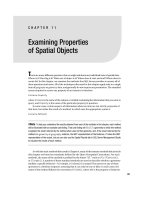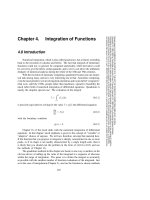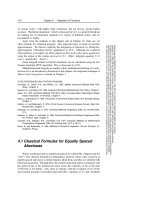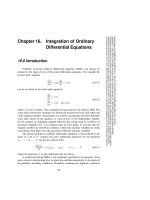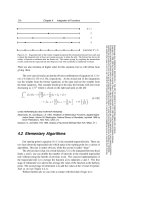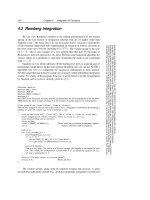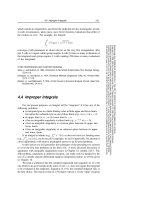Integration of spatial fuzzy clustering with level set for efficient image segmentation
Bạn đang xem bản rút gọn của tài liệu. Xem và tải ngay bản đầy đủ của tài liệu tại đây (1.47 MB, 6 trang )
ISSN:2249-5789
R Poongodi et al , International Journal of Computer Science & Communication Networks,Vol 3(4),296-301
Integration of Spatial Fuzzy Clustering with Level Set for
Efficient Image Segmentation
N. UmaDevi1,R.Poongodi2
1
Research Supervisor,
Head, Department of Computer Science and Information Technology,
Sri Jayendra Saraswathy MahaVidyalayaCollege of Arts and Science,
Coimbatore-5, India.
2
ResearchScholar,
Sri Jayendra Saraswathy Maha VidyalayaCollege of Arts and Science,
Coimbatore-5, India.
Abstract:Image segmentation plays a crucial role in numerous biomedical imaging applications, assisting technicians or
health care professionals during the diagnosis of various diseases.A new fuzzy level set algorithm is proposed in this paper
to facilitate medical image segmentation which is able to directly evolve from the initial segmentation of spatial fuzzy
clustering. The Spatial induced fuzzy c-means using pixel classification and level set methods are utilizing dynamic
variational boundaries for image segmentation. The controlling parameters of level set evolution are also estimated from
the results of clustering. The fuzzy level set algorithm is enhanced with locally regularized evolution. Such improvements
facilitate level set manipulation and lead to more robust segmentation. Performance evaluation of the proposed algorithm
was carried on medical images from different modalities.
Keywords: Fuzzy clustering, Level set, Gradient.
.1. INTRODUCTION
Medical imaging modalities provide an effective means of
noninvasively mapping the anatomy of a subject.
Examples include magnetic resonance imaging (MRI),
computed tomography (CT), computed radiography (CR),
and ultrasonography (US).
These technologies
haveincreased our knowledge of normal and diseased
anatomy and are critical components in diagnosis.
image because the algorithm disregards of spatial
constraint information.If we speedup the computations
involved in FCM, technicians and other health care
professionals could access patient information with nearly
no restrictions of time.
Image segmentation algorithms are important in many
medical imaging applications such as the quantification of
tissue volumes [7], diagnosis [9], localization of pathology
[11], study of anatomical structure [10], treatment
planning [6] and computer-integrated surgery [1], [4].
Among many image segmentation algorithms, fuzzy set
theory has become increasingly attractive due to itsrobust
–ness for ambiguity and can retain much more
information than any other segmentation methods. Fuzzy
sets were introduced in 1965 by LotfiZadeh to reconcile
mathematical modeling and human knowledge in the
engineering sciences [12], and fuzzy algorithms are
widely used today in advanced information technology
[2]. Fuzzy C-Means (FCM) is one of the most well-known
algorithms in image segmentation, and partitions medical
images into non-overlapping, constituent regions that are
homogeneous with respect to some characteristics such as
texture intensity [5][3][8]. However, for large data set,
FCM requires substantial amount of time which limits its
applicability. It is not successful in segmenting the noise
2.1. Image Segmentation: Fuzzy C-Means
2. RELATED WORK
Image Segmentation is the process of partitioning an
image into non-intersecting regions such that each region
is homogeneous and the union of no two adjacent regions
is homogeneous.
Fuzzy c-means (FCM) clustering has been widely used in
image segmentation. However, in spite of its
computational efficiency and wide-spread prevalence, the
FCM algorithm does not take the spatial information of
pixels into consideration, and hence may result in low
robustness to noise and less accurate segmentation.
Application-specific integrated circuits (ASICs) can meet
requirements for high performance and low power
consumption in image segmentation algorithms. Generalpurpose microprocessors (GPPs) or digital signal
processors (DSPs) offer the necessary programmability
and flexibility for various applications. In addition, GPP
manufacturers are also aware of the increased importance
296
ISSN:2249-5789
R Poongodi et al , International Journal of Computer Science & Communication Networks,Vol 3(4),296-301
of multimedia applications and have included multimedia
extensions to their architectures to improve the
performance of multimedia workloads.
3.1. Fuzzy Objective
One of the fundamental challenges of clustering is how to
evaluate results, without auxiliary information. A common
approach for evaluation of clustering results is to use
validity indexes. Clustering validation is a technique to
find a set of clusters that best fits natural partitions
(number of clusters) without any class information.
The fuzzy c-means assigns pixels to c partitions by using
fuzzy memberships. Let X = {x1, x2, x3… xn} denote an
image with n pixels to be partioned into c clusters, where
xi (i = 1, 2, 3 ... n) is the pixel intensity. The objective
function is to discover nonlinear relationships among data,
kernel methods use embedding mappings that map
features of the data to new feature spaces. The proposed
technique Kernel Induced Possibilistic Fuzzy C-Means
(KFCM) is an iterative clustering technique that
minimizes the objective function.
Generally speaking, there are two types of clustering
techniques, which are based on external criteria and
internal criteria.
Given an image dataset, X = {x1…xn}⊂Rp, the original
KFCM algorithm partitions X into c fuzzy subsets by
minimizing the following objective function as,
2.1. Cluster Validity Functions
• External validation: Based on previous knowledge about
data.
• Internal validation: Based on the information intrinsicto
the data alone.
Considering these two types of cluster validation
todetermine the correct number of groups from a dataset,
one option is to use external validation indexes for which
a priori knowledge of dataset information is required, but
it is hard to say if they can be used in real problems.
Another option is to use internal validity indexes which do
not require a priori information from dataset.
3. OUR CONTRIBUTION
The fuzzy clustering based on image intensity is done by
initial segmentation which employs level set methods for
object refinement by tracking boundary variation. The
widely used conventional fuzzy c-means for medical
image segmentations has limitations because of its
squared-norm distance measure to measure the similarity
between centers and data objects of medical images which
are corrupted by heavy noise, outliers, and other imaging
artifacts. To overcome the limitations the proposed
technique Kernel Induced Possibilistic Fuzzy C – Means
(KFCM) with Level Set Segmentation has been
introduced. Compared to previous method FCM, the
proposed KFCM algorithm has significantly improved in
the following aspects. First, the KFCM incorporates
spatial information during an adaptive optimization, which
eliminates the intermediate morphological operations.
Second, the controlling parameters of level set
segmentation are now derived from the results of fuzzy
clustering directly. Finally the proposed algorithm is more
robust to noise and outliers, and still retains computational
simplicity.
c
n
m
J ( w, U , V ) uik
|| xk vi ||2 (1)
i 1 k 1
where c is the number of clusters and selected as a
specified value;nis the number of data points, uik
c
themembership of xk in class i, satisfying the
u
ik
1 , m
i 1
the quantity controlling clustering fuzziness, and V the set
of cluster centers or prototypes (vi ∈Rp).
3.2. Kernel Induced PossibilisticFuzzy C-Means
In fuzzy clustering, the centroid and the scope of each
subclass are estimated adaptively in order to minimize a
pre-defined cost function. It is one of the most popular
algorithms in fuzzy, and has been applied in medical
problems. The fuzzy utilizes a membership function to
indicate the degree of membership of the nth object to the
mth cluster which is justifiable for medical image
segmentation, as physiological tissues are usually not
homogeneous.
The fuzzy utilizes a membership function to indicate the
degree of membership in finding the allocate space and
allocate resources which is justifiable for medical image
segmentation.
Kernel Induced Possibilistic Fuzzy C Means (KFCM)
clustering algorithm is incorporates the spatial
neighborhood information with traditional FCM and
updating the objective function of each cluster. The
KFCM uses the probabilistic constraint that the
memberships of a data point across classes are sum to one.
The kernel induced possibilistic c-means algorithm is used
to minimize the objective function using Gaussian kernel
function.
297
ISSN:2249-5789
R Poongodi et al , International Journal of Computer Science & Communication Networks,Vol 3(4),296-301
The Gaussian function ηi are estimated using,
n
i K
u
k 1
m
ik
2(1 K ( xk , vi ))
possible to approximate the evolution of active contours
implicitly by tracking the zero level set.
(2)
n
u
k 1
m
ik
The fuzzy membership function uik is that the edges
connecting the inner data points in a cluster may have a
larger ―degree of belonging‖ to a cluster than the
―peripheral‖ edges (which, in a sense, reflects a greater
―strength of connectivity‖ between a pair of data points).
For instance, the edges (indexed i) connecting the inner
point in a cluster (indexed k) are assigned uik = 1 whereas
the edges linking the boundary points in a cluster have
uik< 1.
Each cluster is represented by a data point called a cluster
center, and the method searches for clusters so as to
maximize a fitness function called net similarity. The
method is iterative and stops after maximum iterations
(default of 500). It automatically determines the number
of clusters, based on the input p, which is an Nx1 matrix
of real numbers called preferences. A good choice is to set
all preference values to the median of the similarity
values. The number of identified clusters can be increased
or decreased by changing this value accordingly.
The objective function in the clustering problem becomes
more general so that the weights of data points are being
taken into account, as follows:
𝐾
Ck
i=1
𝜙 𝑡, 𝑥, 𝑦 < 0
𝑥, 𝑦 𝑖𝑠 𝑖𝑛𝑠𝑖𝑑𝑒 Γ 𝑡
𝜙 𝑡, 𝑥, 𝑦 = 0
𝑥, 𝑦 𝑖𝑠 𝑎𝑡 Γ 𝑡
𝜙 𝑡, 𝑥, 𝑦 > 0
𝑥, 𝑦 𝑖𝑠 𝑜𝑢𝑡𝑠𝑖𝑑𝑒 Γ(𝑡)
(4)
3.4. Fuzzy With Level Set Algorithm
Both fuzzy algorithms and level set methods are generalpurposed computational model that can be applied to
problems of any dimensions. A new fuzzy level set
algorithm is proposed for automated medical image
segmentation. The algorithm automates the initialization
and parameter configuration of the level set segmentation,
using Kernel Fuzzy clustering.
A new fuzzy level set algorithm automates the
initialization and parameter configuration of the level set
segmentation, using spatial kernel fuzzy clustering. It
employs a KFCM with spatial constraints to determine the
approximate contours of interest in a medical image.
Benefitting from the flexible initializations, the enhanced
level set function can accommodate KFCM results
directly for evolution. The enhancement achieves several
practical benefits. The objective function now is derived
from spatial fuzzy clustering directly. The level set
function will automatically slow down the evolution and
will become totally dependent on the smoothing term.
n
uimj k , kλk +
S(C) =
The level set evolution of active contour implicitly
tracking the zero level setΓ(t),
γjk (Ck )
(𝟑)
j=1
4. IMPLEMENTATION
𝑘 =1
where C denotes the decomposition of the given clusters,
C1, …, CK are not-necessarily disjointclustersin the
decomposition C, γ denotes the modulatingargument,S(C)
denotes the total strength of connectivity cluster,
designates, as in the edge connectivity of cluster, the
weight ui(j)k,k is the membership degree of i(j) containing
data point j in cluster k, and finally, it is the fitness of
cluster j to cluster k.
3.3. Level Set Segmentation
The fuzzy using pixel classification with level set methods
utilizes dynamic variational boundaries for image
segmentation. Segmenting images by means of active
contours is well known approach instead of parametric
characterization of active contours.Level set methods
embed them into a time dependent PDE function. It is
Step 1: Infuzzy clustering process, the input MRI image
and number of clusters areto be initialized. In this process,
fuzzy objective function, membership function and
weights are calculated. To separate the partition matrix
with help of cluster centroid value, the distance matrix is
used to find the similarity index value of black and white
pixels of the image. In the last iteration, the final
partitioned objective function is derived.
Step 2:Contour plot is defined to separate thebackground
and foreground region in the image. The regionsof object
in binary images are found using initial contour and
perimeter functions.
Step 3: 2-D convolution process, Gaussian filter function
creates an image smoothness value which returns the
central part of the image convolution.
Step 4: The image pixel directionsare estimated with the
help of gradient function which can either be scalars to
specify the spacing between points in each direction or
298
ISSN:2249-5789
R Poongodi et al , International Journal of Computer Science & Communication Networks,Vol 3(4),296-301
Step 5: The Neumann boundary or second-type boundary
condition is a type of boundary condition, named after
Carl Neumann. When imposed on an ordinary or a partial
differential equation, it specifies the values that the
derivative of a solution is to take on the boundary of the
domain.
Step 6: In Level set evolution there arethree types of
processes that are integratedin the final segmentation. (i)
The Neumann boundary condition specifies the normal
derivative of the function on a surface. (ii) The Direct
Adaptive Controller method is used by a controller which
must adapt to a controlled system with parameters which
vary, or are initially uncertain. (iii) The curvature central
method is used to separate the gradient coordinate’s
directions and sum of these points is used to find out the
position which evaluates the final segmentation.
5. RESULTS
The result of experiments and performance evolution were
carried on medical images from different modalities,
including an ultrasound image, liver tumors and MRI slice
of cerebral tissues. Both the algorithms of spatial Kernel
Fuzzy induced Clustering and fuzzy level set method were
implemented in matlab R2010. The experiments were
designed to evaluate the usefulness of initial fuzzy
clustering for level set segmentation. It adopted the fast
level set algorithm as in the curve optimization, where the
initialization was by manual demarcation, intensity
thersholding and Spatial KFCM. Due to weak boundaries
and strong background noise, manual initialization did not
lead to an optimal level set segmentation. The intensity
thersholding and fuzzy clustering attracted the dynamic
curve quickly to the boundaries of interest.
Table 1: Structural Similarity Ratio Comparison
Image type
FCM
SKFC
–
Level Set
Liver tumor
0.8002
0.9706
0.7496
0.9866
Ultrasound
artery
carotid
Structural Similarity Ratio
Liver tumor
1
SSIM Ratio
vectors to specify the coordinates of the values along
corresponding dimensions. The variation in space of any
quantity can be represented (e.g. graphically) by a slope.
The gradient represents the steepness and direction of that
slope.
Ultrasound
carotid artery
0.5
0
FCM
SKFC –
Level Set
Figure 5 : Comparison of FCM and SKFC Level Set Methods using SSIM
The test image is matched with existing database to
identify high frequency regions. The Peak signal-to-noise
ratio (PSNR) fraction is most commonly used to measure
the quality of reconstruction of lossy compression coder –
decoder. The signal in this case is the original data, and
the noise is the error introduced by compression.
PSNR 20 log 10( MAXI ) 10 log 10( MSE )
MSE
1 m1 n 1
[ I (i, j) K (i, j)]2
mn i 0 j 0
(5)
Table 2: Peak Signal to Noise Ratio Comparison
For the preprocessing process the following measures are
used, the structural similarity (SSIM) index is a method
for measuring the similarity between two images. The
SSIM index is a full reference metric, in other words, the
measuring of image quality based on an initial
uncompressed or distortion-free image as reference.
Table - 1 shows the comparison of SSIM between the two
methods FCM and SKFC – Level Set.
Image type
FCM
SKFC – Level
Set
Liver tumor
+47.139dB
+47.560dB
Ultrasound
carotid artery
+41.606dB
+47.576dB
299
ISSN:2249-5789
R Poongodi et al , International Journal of Computer Science & Communication Networks,Vol 3(4),296-301
PSNR Ratio
Peak Signal to Noise Ratio
Liver
Tumor
49
48
47
46
45
44
43
42
41
40
39
38
The ultrasound carotid artery tumor is done the SKFC
level set algorithm. The improvements are used to
incorporate fuzzy clustering into level set segmentation
for an automatic parameter configuration. Fig. 3&4
illustrates its performance on the ultrasound image of
carotid artery.
FCM
SKFC - Level Set
Figure 6: Comparison of FCM and SKFC Levelset using PSNR
The liver tumor segmentation from the MRI scan is done
by the fast level set evolution. Segmentation is difficult
because of the weak and irregular boundaries. The liver
tissue itself is in-homogeneous, due to blood vessels.
Again, it is challenging to determine an optimal
initialization and the corresponding level set parameters.
The results show that a fuzzy clustering has the best
performance in terms of level set evolution. The proposed
algorithm seems trivial in medical images with
comparatively clear boundaries. However, in images
without distinct boundaries, it would be very important to
control the motion of the level set contours. In contrast,
the new fuzzy level set algorithm is able to find out the
controlling
parameters
from
fuzzy
clustering
automatically.
Fig. 3: Kernel Induced Possibilistic C-means Cluster
indexing ultrasound carotid artery Result.
Fig. 4: SKFC level set segmentation of ultrasound
carotid artery.
6. CONCLUSION
Fig. 1: Kernel Induced Possibilistic C-means Cluster
Indexing of Liver tumor Result.
In this paper we have worked with a spatial kernel
induced Fuzzy level set algorithm that has been proposed
for automated MRI image segmentation. The enhanced
FCM algorithms with spatial information can approximate
the boundaries of interest well. The level set evolution
will start from a region close to the genuine boundaries.
The algorithm estimates the controlling parameters from
spatial clustering automatically. This has reduced the
manual intervention. Finally the fuzzy level set evolution
is modified locally by means of spatial fuzzy clustering.
All these improvements lead to a robust algorithm for
medical image segmentation.
Fig. 2:SKFC level set segmentation of CT Liver tissue
300
ISSN:2249-5789
R Poongodi et al , International Journal of Computer Science & Communication Networks,Vol 3(4),296-301
REFERENCES
Authors Profile
[1] Ayche, N.,Cinquin, P., Cohen, I., Cohen, L., Leitner,
F. and Monga, O., (1996) ―Segmentation of complex
three-dimensional medical objects: A challenge and a
requirement for computer-assisted surgery planning and
performance,‖ in Computer Integrated Surgery,
Technology and Clinical Applications.,Pp. 59–74.
[2] Bezdek, J. C., Keller, J.,Krisnapuram, R. and Pal, R.,
(2005) ―Fuzzy Models and Algorithms for Pattern
Recognition and Image Processing‖. New York: SpringerVerlag.
[3] Gonzalez, R. C. and Woods, R. E.,(1992 ) ― Digital
Image Processing‖ Reading, MA: Addison-Wesley.
[4] Grimson, W. E. L.,Ettinger, G. J., Karpur, T.,
Leventon, M. E., Wells, W. M. and Kikinis, R., (1997)
―Utilizing segmented MRI data in imageguided surgery,‖
International Journal of Pattern Recognition and Artificial
Intelligence., Vol. 11, No. 8, Pp. 1367–1397.
[5] Haralick, R M. and Shaprio, L. G.,(1985) ―Image
segmentation techniques,‖ Computer Vision Graphic
Image Processing., Vol. 29, No. 1, Pp. 110–132.
[6] Khoo, V. S., Dearnaley, D. P., Finnigan, D. J.,
Padhani, A., Tanner, S.F. and Leach, M. O (1997)
―Magnetic resonance imaging (MRI): Considerations and
applications in radiotherapy treatment
planning,‖
Radiotherapy Oncology., Vol. 42, No. 1, pp. 1–15.
[7] Lawrie, S. andAbukmeil, S., Mar (1998) ―Brain
abnormality in schizophrenia. A systematic and
quantitative review of volumetric magnetic resonance
imaging studies,‖ British Journal ofPsychiatry., Vol. 172,
Pp. 110–120.
[8] Pal, N. R. and Pal, S. K., (1993) ―A review on image
segmentation techniques,‖ Pattern Recognition., Vol. 26,
No. 9, Pp. 1277–1294.
[9] Taylor, P.,Sep (1995) ―Invited review: Computer aids
for decision-making in diagnostic radiology—a literature
review,‖ British Journal ofRadiology., Vol. 68, No. 813,
Pp. 945–957.
[10] Worth, A.J., Makris, N., Caviness, V. S.
andKennedy,
D.N.,
(1997)
―Neuroanatomical
segmentation in MRI: Technological objectives,‖
International Journal of Pattern Recognition and Artificial
Intelligence., Vol. 11, No. 8, Pp. 1161–1187.
[11] Zijdenbos, A.P. and Dawant, B.M., (1994)―Brain
segmentation and white matter lesion detection in MR
images.‖ Review of Biomedical Engineering.,Vol. 22,
Nos. 5–6, Pp. 401–465.
[12] Zadeh, L. A., (1965) "Fuzzy sets". Information and
Control., Vol. 8, No. 3, Pp. 338–353.
301

